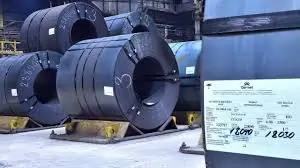Kazakhstan occupies a strategic position in Eurasian steel trade. Rich in mineral resources and with an expanding industrial base, the country is both a consumer and a growing exporter of steel products. Among those, hot-rolled steel coils play an outsized role: they are a basic intermediate product used by downstream manufacturers in construction, automotive, pipe production, and machinery. This article reviews Kazakhstan’s hot-rolled coil export landscape — the drivers behind export flows, typical destinations, logistical and regulatory considerations, pricing dynamics, and the outlook for exporters and buyers.
Table of Contents
ToggleWhat are hot-rolled steel coils and why they matter
Hot-rolled coils are produced by rolling steel at high temperatures, resulting in a product that is ductile, workable, and suitable for a wide range of industrial applications. As a commodity-grade steel product, hot-rolled coils are a bellwether for wider industrial demand: construction booms, infrastructure projects, and manufacturing growth typically increase demand for hot-rolled coils. For Kazakhstan, exporting these coils links its steelmaking capacity to regional manufacturing hubs and global supply chains.
Kazakhstan’s position in the regional steel market
Kazakhstan’s domestic steel production is smaller than that of heavyweight producers such as China, Russia, or India, but it has competitive advantages: geographic proximity to Central Asian, Caucasus and some European markets; access to raw materials through regional supply chains; and improving logistics infrastructure (rail corridors and road routes connecting to China, Russia, and the Caspian ports). Small and mid-scale mills in Kazakhstan focus on commodity products including hot-rolled coils, galvanised sheet, and structural steel. These mills often target regional buyers that prefer shorter lead times and tailored trade terms compared with distant suppliers.
Export destinations and trade corridors
Kazakh hot-rolled coils are typically bound for neighboring and nearby markets where demand for construction-grade steel is steady. Common destination categories include:
-
Central Asia: Uzbekistan, Kyrgyzstan, and Tajikistan often import coils for infrastructure and industrial projects. Proximity reduces freight costs and delivery time, making Kazakh product competitive.
-
Russia and the Caucasus: Although Russia is itself a major steel producer, specific regional dynamics (trade agreements, localized demand spikes, or logistical advantages) create pockets of trade between Kazakhstan and certain Russian regions or Caucasus countries.
-
China: Cross-border trade to China is sometimes observed, especially for niche grades or when logistics favor rail shipments. However, China’s domestic capacity generally limits consistent large-scale imports.
-
Middle East & South Asia (select shipments): Where logistics via Caspian routes or port transshipment is economical, Kazakhstan can serve niche buyers in these regions.
Trade corridors typically rely on rail (Eurasian rail links), road transport for shorter distances, and, for farther markets, multimodal routes via Caspian ports and transshipment through Black Sea hubs. These options make Kazakhstan a flexible—but not dominant—supplier.
Export volumes and seasonality (qualitative view)
Export volumes of hot-rolled coils from Kazakhstan tend to follow domestic production cycles and regional demand signals. When regional infrastructure projects accelerate or when neighboring economies experience construction booms, exports rise. Conversely, global steel price volatility and low demand cycles depress export volumes. Seasonality can matter too: construction slowdowns in winter months in colder climates sometimes reduce immediate demand and shift shipment timing toward warmer months.
Price drivers and margins
Hot-rolled coil export prices from Kazakhstan reflect a blend of factors:
-
Global commodity prices: Steel pricing is influenced by global scrap, iron ore, and energy costs. Kazakhstan’s producers track international indices closely.
-
Logistics costs: Rail and transshipment fees, port handling, and road haulage meaningfully affect landed prices for regional buyers.
-
Quality and grade: Standard commodity coils are price-sensitive; higher-value or tighter-tolerance coils command premiums.
-
Trade policy: Duties, quotas and bilateral trade agreements with neighbors can shift competitiveness.
-
Currency fluctuations: Exporters pricing in USD or other hard currency are affected by tenge exchange rates, which can compress or expand margins.
Because of these variables, exporters often hedge their exposure through forward contracts, long-term supply agreements, or by diversifying customer bases.
Regulatory and compliance considerations
Exporters must meet both domestic regulations and destination country requirements. Common compliance items include:
-
Material certificates and mill test reports that verify chemical composition and mechanical properties.
-
Customs documentation and correct HS codes to avoid delays and penalties.
-
Quality standards requested by buyers (EN, ASTM, GOST or locally accepted equivalents).
-
Environmental and social governance (ESG) expectations are rising among buyers; mills that can demonstrate lower emissions or better working-condition practices may find better access to premium markets.
Navigating these requirements efficiently reduces lead times and improves buyer confidence.
Logistics challenges and solutions
Key logistics challenges for Kazakhstan’s hot-rolled coil exporters include rail capacity constraints, seasonal weather impacts, and transshipment bottlenecks at major hubs. Solutions that market participants pursue:
-
Longer term rail contracts with carriers to secure slot allocations.
-
Use of multimodal logistics—combining rail, road and sea—to optimize cost and lead time.
-
Investment in packing and preservation (coated wraps, sealed containers) to prevent corrosion during transit.
-
Digital tracking and improved documentation workflows to speed customs clearance across borders.
Market risks and mitigation
Major risks to exporters include sudden changes in global steel prices, protective trade policies in target markets, and disruptions to freight corridors. Mitigation strategies:
-
Diversify markets across several neighboring countries.
-
Establish flexible pricing clauses tied to benchmark indices.
-
Maintain inventory buffers when feasible to meet urgent orders.
-
Invest in longer-term contracts with key customers to ensure predictable volumes.
Opportunities and future outlook
Several trends point to modest growth potential for Kazakh hot-rolled coil exports:
-
Regional infrastructure investment in Central Asia and the Caucasus continues to create demand for structural steel.
-
Improving Eurasian logistics—rail infrastructure projects and port upgrades—reduce transit times and costs.
-
Value chain development within Kazakhstan, such as increased downstream processing, could allow exports of higher-value products over time.
-
Green transition: If Kazakh mills adopt lower-carbon steelmaking methods, they can appeal to markets prioritizing sustainability.
However, Kazakhstan will likely remain a regional rather than global steel exporter for the near term. Its strength lies in proximity and reliability to neighboring buyers rather than competing on volume with global majors.
Practical tips for buyers and exporters
-
Buyers should request full mill test certificates and check transit protections (packaging and insurance). Comparing landed costs from Kazakhstan versus other suppliers helps evaluate competitiveness.
-
Exporters should prioritize consistency in documentation, pursue long-term logistics contracts, and explore value-added processing that can capture higher margins.
Conclusion
Cheap Hot-rolled steel coils are a vital export commodity for Kazakhstan’s steel sector, linking domestic production to nearby construction and industrial markets. While Kazakhstan will not unseat the major global steel producers, its geographic position and improving logistics give it durable regional relevance. For both buyers and sellers, success will depend on managing logistics efficiently, adhering to quality and compliance standards, and aligning offers with the evolving needs of neighboring markets.






